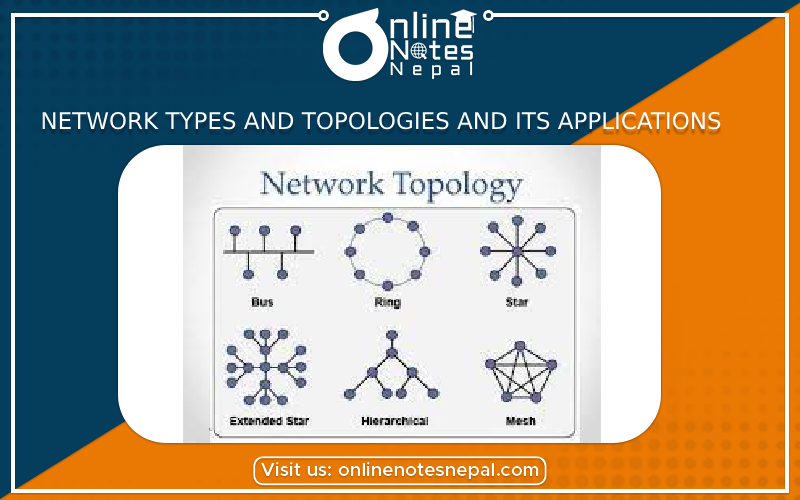Published by: Anu Poudeli
Published date: 30 Jul 2023

Networks are crucial in connecting devices and facilitating communication and data exchange.There are different types of networks and topologies, each with its own advantages and applications. Let's explore some of the common network types and topologies:
1.Network Structures:
1.LAN (Local Area Network):
A LAN is a network that typically spans a small geographic region, such as a single building or school. It enables computers and devices to share resources such as files, printers, and internet access. Local area networks (LANs) are widely utilized in workplaces, households, and educational institutions.
b. WAN (Wide Area Network):
A WAN connects numerous LANs over long distances across a vast geographic area. WANs make use of public or private communication channels such as leased lines, satellites, or the internet. They offer global communication and are widely utilized to connect a company's remote offices and branches.
c. Metropolitan Area Network (MAN):
A MAN is a network that serves a city or metropolitan region and spans a bigger area than a LAN but is smaller than a WAN. Organizations and service providers utilize MANs to connect several LANs or to provide high-speed internet access to a specific geographic area.
d.WLAN (Wireless Local Area Network):
A WLAN is a sort of LAN that connects devices to the network using wireless communication technologies such as Wi-Fi rather than physical wires. WLANs are widely utilized for easy and convenient connectivity in homes, offices, airports, cafes, and public locations.
e. Virtual Private Network (VPN):
A VPN is a secure network that allows remote users or offices to connect to a private network over the internet. It provides encryption and authentication, ensuring secure data transmission between connected devices. VPNs are commonly used for remote work, enabling employees to access company resources from outside the office securely.
2. Topologies of Networks:
a. Bus Organization:
All devices in a bus topology are connected to a single central cable (the "bus"). Data is transmitted by one device and received by all other devices on the network via the bus. This topology is simple to implement, but it might cause data collisions and performance concerns as the network grows in size.
b. Topology of Stars:
A central hub or switch to which all devices are directly connected is used in a star architecture. The hub routes data traffic, and each device has its own dedicated connection. This topology outperforms the bus topology in terms of performance and ease of management.
c. Ring Topology: A ring topology connects devices in a circular fashion, forming a closed-loop. Each device is linked to two others, resulting in a continuous data route. While this topology prevents data collisions, a single device or link failure can bring the entire network down.
d.Mesh Topology :Every device in a mesh topology is directly connected to every other device, providing a completely interconnected network. This redundancy ensures dependable communication by providing high fault tolerance and many data channels. Mesh topologies are often employed in critical applications that require continuous communication.
Network Types and Topologies in Use:
LANs: Local area networks (LANs) are used in workplaces, residences, schools, and small enterprises for data sharing, printing, and internet access.
WANs: Wide-area networks (WANs) are used by international corporations, internet service providers (ISPs), and governments to connect remote locations and share data across great distances.
MANs: MANs are often used to connect the LANs of various buildings or offices within a city or metropolitan area.
WLANs: Wireless local area networks (WLANs) allow wireless connectivity in a variety of settings, including residences, cafes, airports, and public spaces.
VPNs: Virtual private networks (VPNs) are utilized by distant workers, business travelers, and businesses to securely access company resources over the internet.
Bus Topology: While bus topologies are less widespread today, they were previously employed in smaller LANs because to their simplicity and cost-effectiveness.
Star topologies are extensively utilized in LANs because they provide higher performance and are easier to operate.
Ring Topology: Some local networks and telecommunications networks use ring topologies.
Mesh Topology: Mesh topologies are employed in high-reliability applications such as stock exchanges, military communications, and emergency response systems.
Hybrid topologies are used when individual network segments have specific requirements, such as combining the simplicity of a star topology with the redundancy of a bus topology.
In conclusion, diverse network types and topologies serve specific functions, with applications ranging from home networks to global communications and vital infrastructure. The best network type and architecture are determined by criteria such as scale, geographic dispersion, reliability requirements, and financial limits.